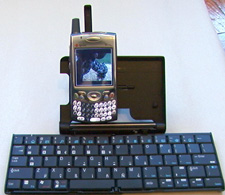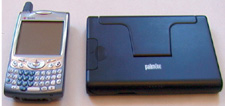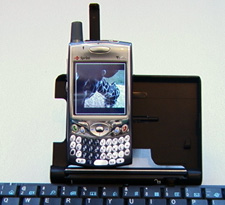 The original Stowaway keyboard from ThinkOutside was a marvel of engineering. Coupled with a Palm or Handspring unit, it took the handheld to levels far beyond the capabilities of a simple PDA. The PalmOne Universal Wireless Keyboard is a direct descendent of the original Stowaway, with subtle enhancements and changes that make it an admirable companion for the Treo.
The original Stowaway keyboard from ThinkOutside was a marvel of engineering. Coupled with a Palm or Handspring unit, it took the handheld to levels far beyond the capabilities of a simple PDA. The PalmOne Universal Wireless Keyboard is a direct descendent of the original Stowaway, with subtle enhancements and changes that make it an admirable companion for the Treo.
Design
After all this time, the unfolding of a keyboard still leaves me a bit in awe of the engineering to achieve such a feat. In a case not much bigger than the Treo itself, the unit slides apart, gracefully unfurls its �wings�, and snaps into place. At the same time, a stand for the Treo flips out. The keyboard is also usable with many other Palm and Pocket PC devices, as this is a universal keyboard.
 The keyboard connects to the Palm wirelessly through an infrared wand that swivels to the top of the unit. The wand actually has 180 degrees of play so it can be used in landscape mode with a device like the Tungsten T5. On the stand, a little metal bar slides up to help hold the unit in place. Two AAA batteries are included and are rumored to last up to four months. They are easy to install in a compartment on the bottom of the unit � though the battery door can inadvertently slip off if you grab the keyboard the wrong way.
The keyboard connects to the Palm wirelessly through an infrared wand that swivels to the top of the unit. The wand actually has 180 degrees of play so it can be used in landscape mode with a device like the Tungsten T5. On the stand, a little metal bar slides up to help hold the unit in place. Two AAA batteries are included and are rumored to last up to four months. They are easy to install in a compartment on the bottom of the unit � though the battery door can inadvertently slip off if you grab the keyboard the wrong way.
Upon insertion of the setup CD-ROM, a clear screen pops up (assuming auto play is enabled in Windows), offering the option of installing the Palm or Pocket PC driver. Also on this main screen are options for a PDF manual in eight different languages. A click or two later, and the driver is installed. The readme file automatically pops up (a nice touch) warning that the combination of Treo, Goodlink, and the wireless keyboard may be incompatible.
The keyboard has all of the standard keys from the number keys to the space bar, no function keys however. The spacebar however is split in two; nonetheless, the position does not seem to affect typing. The QWERTY keys appear to be full sized, while some compromises have been made on other keys, such as shift and enter. The number keys are also sub-standard size. As for layout, it is mostly the same as a standard keyboard except arrow keys are crammed in on the bottom right and the �?� �/� key has been banished to the right of the right-hand shift key.
Functionality
 Basic typing works out well. I'm a seven finger typist (Ed: Seven?) and I don't have trouble hitting the keys. It does take some getting used to, especially since the keys do not have full travel. Touch typists should easily be able to adapt to the keyboard. The travel on the keys takes a simple light touch and I like the gentle responsiveness of the keys. There is even a subtle �click� sound when the keys are depressed.
Basic typing works out well. I'm a seven finger typist (Ed: Seven?) and I don't have trouble hitting the keys. It does take some getting used to, especially since the keys do not have full travel. Touch typists should easily be able to adapt to the keyboard. The travel on the keys takes a simple light touch and I like the gentle responsiveness of the keys. There is even a subtle �click� sound when the keys are depressed.
Because there is no mouse involved, keyboard shortcuts are now a necessity. The keyboard assigns numerous keys extra functions via the use of a function key �Fn�, a Command Key �Cmd� and the usual �Ctrl� key. The top number row has an extra blue silk screen with symbols for such actions as menu pull down, and find plus shortcuts for all of the major Palm applications when used in combination with the function Fn key. The top row is also customizable through the keyboard control panel to be used in conjunction with the Ctrl key. Also towards the right of the keyboard are several other commands accessible in conjunction with the Fn key such as new, edit send. There is even a key to tell you the status of the keyboard battery.
There are also some silkscreens on the QWERTY row that are for use with Pocket PCs only and it seems a shame that these cannot be customized for Palm use. In effect, PocketPC users have two rows of function keys (one customizable and one not), whereas Palm users have to make the top row do double duty. It may not seem like much, but I�d like to map the silk screen on the �E� to Documents to go (it has a Word icon on it) but I can�t.
I suppose in an effort to make the keyboard truly universal, the designers chose to include special characters on the lower right hand corner of some of the keys. Ultimately, I feel that these extra silk screens on the keys simply clutter up the works.
The help file gives a list of other special characters and commands and also includes information on how to replace the five way navigator through the use of the Cmd key combined with the arrow keys and the enter key. This is a real boon to Treo users. Alas the help file that gives you this information itself is not navigator aware, and you may need to resort to stylus use to use it.
Conventional wisdom states that using keyboard shortcuts is ultimately faster than using a pointing device or scrolling through menus. Relying on the keyboard for all functions is not only possible, but desirable for increase efficiency. Some of the newer keyboards remove the top number keys and I feel this is a huge mistake.
Finally, in making this a universal keyboard, the stand does not latch onto the PDA like dedicated units did. So the Treo can slide around a bit though doesn�t seem likely to actually fall off the stand. Also note that using the IR does chew up more battery on the Treo and using the driver does knock out the beaming functions. Fortunately, the control panel for the keyboard includes easy power saving options and the ability to turn off the driver.
Conclusion >>
Copyright 1999-2016 TreoCentral. All rights reserved :
Terms of Use : Privacy Policy
TREO and TreoCentral are trademarks or registered trademarks of palm, Inc. in the United States and other countries;
the TreoCentral mark and domain name are used under license from palm, Inc.
The views expressed on this website are solely those of the proprietor, or
contributors to the site, and do not necessarily reflect the views of palm, Inc.
Read Merciful by Casey Adolfsson
 The original Stowaway keyboard from ThinkOutside was a marvel of engineering. Coupled with a Palm or Handspring unit, it took the handheld to levels far beyond the capabilities of a simple PDA. The PalmOne Universal Wireless Keyboard is a direct descendent of the original Stowaway, with subtle enhancements and changes that make it an admirable companion for the Treo.
The original Stowaway keyboard from ThinkOutside was a marvel of engineering. Coupled with a Palm or Handspring unit, it took the handheld to levels far beyond the capabilities of a simple PDA. The PalmOne Universal Wireless Keyboard is a direct descendent of the original Stowaway, with subtle enhancements and changes that make it an admirable companion for the Treo.
 The keyboard connects to the Palm wirelessly through an infrared wand that swivels to the top of the unit. The wand actually has 180 degrees of play so it can be used in landscape mode with a device like the Tungsten T5. On the stand, a little metal bar slides up to help hold the unit in place. Two AAA batteries are included and are rumored to last up to four months. They are easy to install in a compartment on the bottom of the unit � though the battery door can inadvertently slip off if you grab the keyboard the wrong way.
The keyboard connects to the Palm wirelessly through an infrared wand that swivels to the top of the unit. The wand actually has 180 degrees of play so it can be used in landscape mode with a device like the Tungsten T5. On the stand, a little metal bar slides up to help hold the unit in place. Two AAA batteries are included and are rumored to last up to four months. They are easy to install in a compartment on the bottom of the unit � though the battery door can inadvertently slip off if you grab the keyboard the wrong way.
 Basic typing works out well. I'm a seven finger typist (Ed: Seven?) and I don't have trouble hitting the keys. It does take some getting used to, especially since the keys do not have full travel. Touch typists should easily be able to adapt to the keyboard. The travel on the keys takes a simple light touch and I like the gentle responsiveness of the keys. There is even a subtle �click� sound when the keys are depressed.
Basic typing works out well. I'm a seven finger typist (Ed: Seven?) and I don't have trouble hitting the keys. It does take some getting used to, especially since the keys do not have full travel. Touch typists should easily be able to adapt to the keyboard. The travel on the keys takes a simple light touch and I like the gentle responsiveness of the keys. There is even a subtle �click� sound when the keys are depressed.